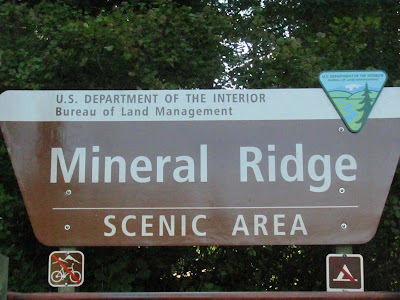Following Coeur d'Alene, I headed back east towards Montana, stopping at Lookout Pass, Mile Marker 0, I-90, Montana. But actually, Lookout Pass is located in Idaho. One of the original U.S. ski areas, Lookout Pass was first used by the local Scandanavians who hopped off the Northern Pacific freight cars to enjoy a day of alpine skiing. A tow rope was installed in 1936, but it was officially opened as Lookout Pass Ski area on February 24, 1938. A maintenance shed, nicknamed "Buzzards Roost", was used as a warming hut with a pot belly stove and soup and sandwiches. In 1941, the CCC constructed a lodge, which has since been added on to, but the original is still in use today. Since it is located on the Montana-Idaho state line, it is one of three ski area where you can ski in two states.
During the summer, the lodge becomes the headquarters for those planning on biking the Hiawatha Trail. You can rent bikes, helmets, flashlights and obtain your Hiawatha Trail Pass and shuttle ticket all right here. The lodge was kind enough to allow the WINs to park and have a gathering in their parking lot. We took up a collection and made a donation to their ski school, which is provided free to a group of students every year.
In addition to biking the Hiawatha Trail, some of us wanted to bike the Trail of the Coeur d'Alene from Mullen down to Caltaldo, about a 30 mile ride. The first 15 miles was pretty much all downhill, then it leveled out from Kellogg to Caltaldo.
 |
| At the trailhead in Mullen. |
 |
The early part of the trail was shaded and in the pines. It was close to I-90, but you really didn't notice. The day before we spotted a bear on the bike trail, but no one saw it today. |
 |
From Mullen to Wallace found us riding alongside this creek. |
 |
The area where the Zinc Plant once was is now an industrial area outside of Kellogg. |
 |
| I remembered seeing highway signs advertising the Snake Pit, but it looks like hard times have claimed the place. |
It was a great ride, even if it was 30 miles. I have found if I wear two sets of padded bike shorts, I don't get sore and I don't mind the longer rides.
A couple days later the group biked the Hiawatha Trail. Since there were almost 20 of us, Carolyn negotiated a group rate for the price of our trail passes and shuttle tickets. The Hiawatha Trail is a 14.4 mile trail, starting off mile marker 5 in Montana. Although most people simply ride down and take the shuttle back to the top, some bike it both ways. It is a 1000 foot descent down, but never more than a 3% grade. All of us opted to take the shuttle. The trail starts with a 1.7 mile tunnel. Yes, it is required that you have good flashlights. Six of us decided to start at the end of the tunnel, skipping the first tunnel. I don't like enclosed spaces, and even though it really wasn't enclosed, the dark made it feel that way. I'm glad I opted out of the first tunnel. But no worries, there were nine more tunnel which I did travel, the longest being over 1200 foot, another 900 foot, one 700 foot, the rest from 200 foot to 600 foot.
The Hiawatha Trail was the route identified in 1905 for the Milwaukee and St. Paul Railway to wind it's way over the Bitterroot Mountains.
 |
| One of the nine trestles you cross on the ride. |
One of the many stories of heroics during the fire of 1910, engineer Johnnie Mackedon found the Falcon siding on fire. He found over 100 men, women and children were gathered on the side of the smoldering depot. Johnnie coupled a flat car to his engine and everyone scrambled on board for the ride to tunnel 27. One passenger panicked and jumped off before reaching the tunnel and he was the only casualty, everyone else reached safety from the fire.
 |
| We made it to the bottom and here is our shuttle driver. What is that in her pocket? She puts nuts in her pocket and the chipmonks climb up and into the pocket to get the nut. |
 |
| After he gets the nut, he sits and enjoys it, I'm sure, hoping he'll get more. |
It wasn't just my birthday this week, but also Pat Ackley's. In fact, our birthdays are the same day. So we had a double celebration.
 |
Yep, we each got our own cake. |
 |
And hey, don't ask us our age! |
 |
| On the actual day of our birthday, we went to Wallace and celebrated at the Fainting Goat Wine Bar with a few friends. What a wonderful way to celebrate a birthday! |







































